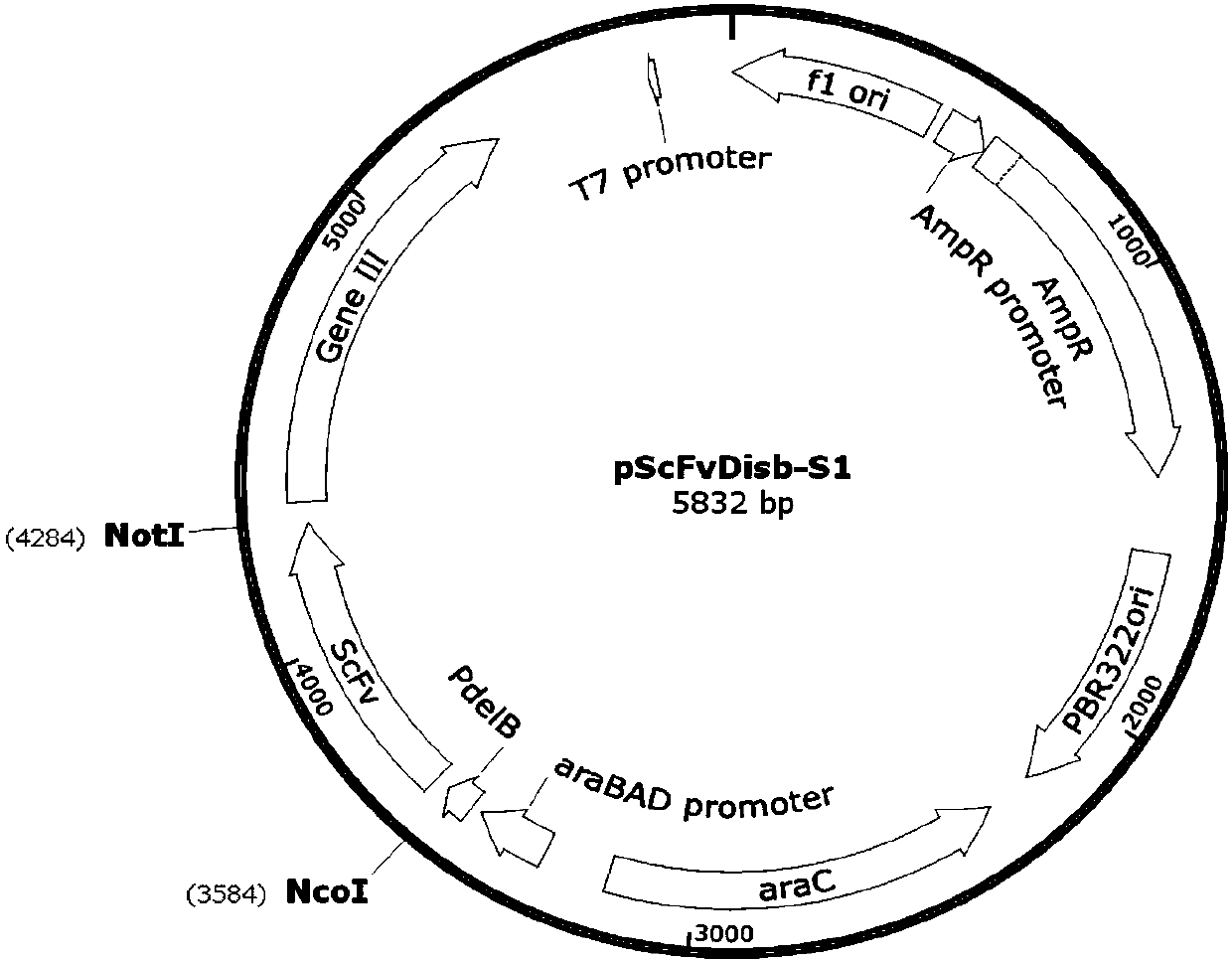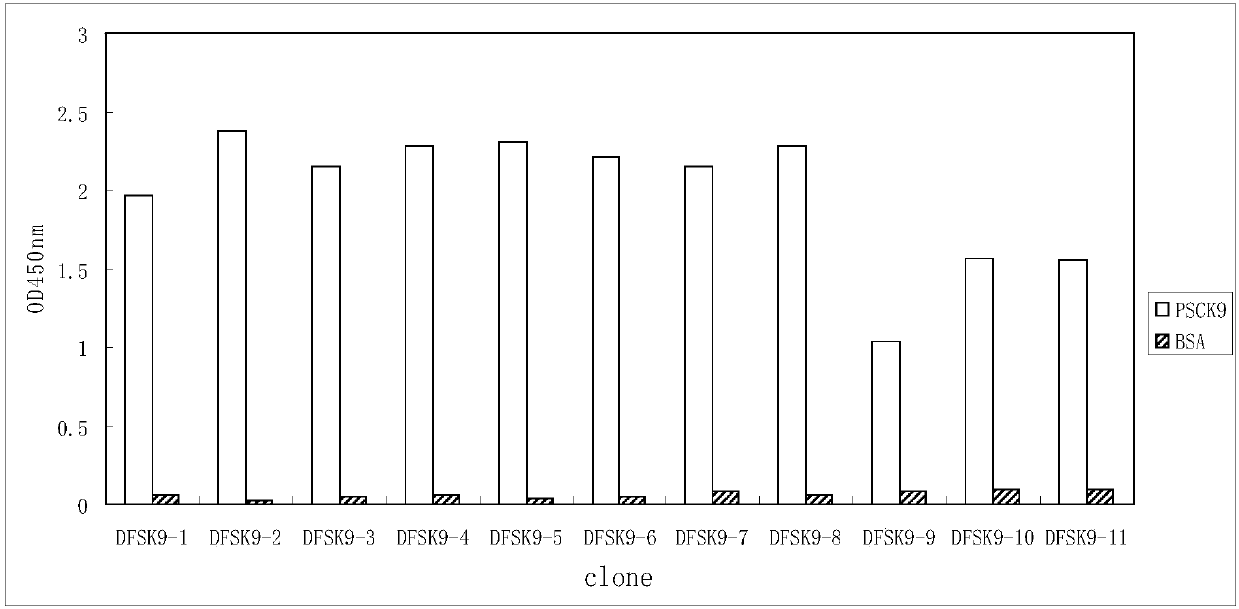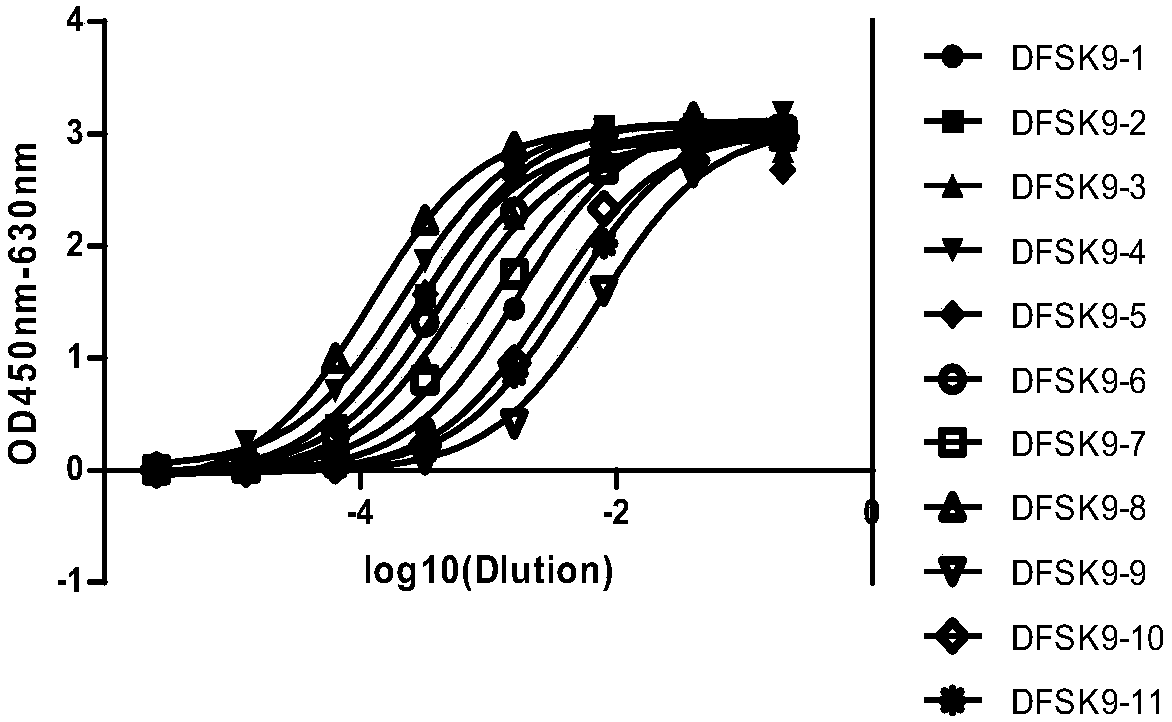PCSK9 (Proprotein Convertase Subtilisin Kexin Type 9) resistant monoclonal antibody
A monoclonal antibody, antibody technology, applied in the direction of antibodies, antibody medical components, anti-enzyme immunoglobulins, etc., can solve the problem of lack of fully human antibodies and achieve good functions
- Summary
- Abstract
- Description
- Claims
- Application Information
AI Technical Summary
Problems solved by technology
Method used
Image
Examples
Embodiment 1
[0067] Example 1. Biopanning of anti-PCSK9 single chain antibody
[0068] The pCom3 vector was modified by the method of gene cloning, and the modified vector was named pScFvDisb-S1( figure 1 ). Construct a fully synthetic phage antibody library based on this vector.
[0069] The immune tube was coated with antigen PCSK9-His 10μg / 1ml / tube, and coated overnight at 4°C. Use PBST-4% milk to seal the immune tube and phage antibody library respectively (the amount of phage input is about 10 9 -10 12 ), sealed at 37°C for 1h. The blocked phage antibody library was added to the immunotube for antigen-antibody binding, and reacted at 37°C for 1 hour. PBST-PBS washed away unbound phage, 0.1M pH2.2 Glycine-HCl eluted, and 1.5M pH8.8 Tris-HCl neutralized the eluate to about pH 7.0. The eluate was infected with 10 ml of XL1-Blue bacterial solution that had grown to an OD value of about 0.5-0.8, and was first allowed to stand at 37°C for 30 minutes and then cultured with shaking at 150 rpm ...
Embodiment 2
[0070] Example 2. Screening of positive clones of anti-PCSK9 single chain antibody
[0071] After three rounds of screening, pick the well-separated monoclonal colonies and inoculate them in a 96-well deep-well plate with 2YTATG liquid medium. Incubate at 37°C and 220 rpm for about 5 hours to their logarithmic growth phase. Add about 10 to each well. 10 The helper phage M13KO7 was allowed to stand at 37°C for 30 minutes and then cultured with shaking at 150 rpm for 1 hour. After centrifugation at 4000 rpm for 15 min, the pellet was resuspended in 2YTATKA liquid medium and incubated overnight at 28°C at 220 rpm. Centrifuge at 4000 rpm and 4°C for 15 min, and draw the phage-containing supernatant for monoclonal ELISA identification. The high-affinity single-chain antibody DFSK9-1 was screened. Its heavy chain variable region was named DFSK9-H1, and its amino acid sequence was shown in SEQ NO. 1; its light chain variable region was named DFSK9-L1, and its amino acid sequence was sho...
Embodiment 3
[0074] Example 3. In vitro affinity maturation of single chain antibody DFSK9-1
[0075] 3.1. Construction of DFSK9-1 light chain CDR123 mutation library
[0076] The pScFvDisb-DFSK9-1 plasmid was double digested with NheI and NotI. After the digested product was agarose gel electrophoresis, the gel was cut to recover a band with a size of 5.5kb; the synthesized light chain mutation library gene VLCDR123M was performed with NheI and NotI Double enzyme digestion, universal product recovery kit to recover the product. The mutant library gene and the carrier were ligated at a ratio of 3:1 by mole ratio by T4DNA ligase at 16℃ for 4h. The ligation product was transformed into XL1-Blue electroporation competence by the electric shock method. Incubate at 37°C with shaking at 150 rpm for 1 hour to recover. Take 1% bacterial solution, apply a small plate after dilution, and calculate the storage capacity. After the remaining bacterial liquid was centrifuged at 4000 rpm for 15 minutes, t...
PUM
 Login to View More
Login to View More Abstract
Description
Claims
Application Information
 Login to View More
Login to View More - R&D
- Intellectual Property
- Life Sciences
- Materials
- Tech Scout
- Unparalleled Data Quality
- Higher Quality Content
- 60% Fewer Hallucinations
Browse by: Latest US Patents, China's latest patents, Technical Efficacy Thesaurus, Application Domain, Technology Topic, Popular Technical Reports.
© 2025 PatSnap. All rights reserved.Legal|Privacy policy|Modern Slavery Act Transparency Statement|Sitemap|About US| Contact US: help@patsnap.com



